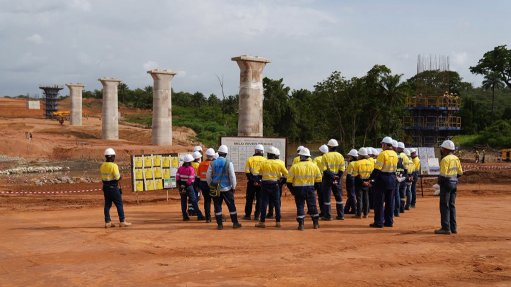
Rio Tinto Simfer developing rail infrastructure for the Simandou project.
The major Simandou iron-ore mine and infrastructure project, in Guinea, has cleared all regulatory hurdles, marking the path forward for $11.6-billion integrated development.
The project, hailed as the biggest greenfield mine and infrastructure investment in Africa, has received key approvals from both the Guinea and Chinese governments.
The government approvals have set the stage for the Simfer joint venture (JV), which includes Rio Tinto and Chinese partners, to invest in and fund their shares of the co-developed rail and port infrastructure being progressed by the Winning Consortium Simandou (WCS), Baowu and the Guinea government.
More than 600 km of new multi-use trans-Guinean railway together with port facilities will allow the export of up to 120-million tonnes a year of mined iron-ore by Simfer and WCS from their respective Simandou mining concessions in the southeast of the country.
Rio Tinto owns two of the four Simandou mining blocks as part of the Simfer JV with China’s Chalco Iron Ore Holdings (CIOH) and the Guinea government.
Simfer will own, develop and operate a 60-million-tonne-a-year mine in blocks 3 and 4 of the Simandou project and WCS is developing blocks 1 and 2. Together, Simandou will yield about 120-million tonnes a year of premium iron-ore, once operating at full capacity.
First production is expected by the end of next year.
“We thank the government of Guinea, Chinalco, Baowu and WCS for their partnership in reaching this milestone towards developing the world class Simandou project,” commented Rio Tinto executive lead for Guinea and copper CEO Bold Baatar.
“Simandou will deliver a significant new source of high-grade iron-ore that will strengthen Rio Tinto’s portfolio for the decarbonisation of the steel industry, along with trans-Guinean rail and port infrastructure that can make a significant contribution to the country’s economic development,” he added.
Under the terms of the transaction, Simfer will acquire a participation in the WCS project companies constructing rail and port infrastructure, commit to perform a portion of the construction works itself and commit to funding its share of the overall co-developed infrastructure cost, in an aggregate amount of about $6.5-billion, of which Rio Tinto's share is $3.5-billion.
Rio Tinto reports that CIOH has paid its share of capital expenditures incurred or required by Simfer to progress critical works up to completion. A first payment of $410-million, for expenditures until the end of 2023, was made in late June, and a second payment of $575-million, for 2024 expenditures, was made last week.
Simfer and WCS will deliver separate infrastructure scopes to leverage expertise. Simfer will construct the 70 km Simfer spur rail line and a 60-million tonne a year transhipment vessel port, while WCS will construct the dual track 536 km main rail line, the 16 km WCS spur rail line and a 60-million tonne a year barge port.
Once complete, all co-developed infrastructure and rolling stock will be transferred to and operated by the Compagnie du Transguinéen JV, in which Simfer and WCS each hold a 42.5% equity stake and the Guinean State a 15% equity stake.